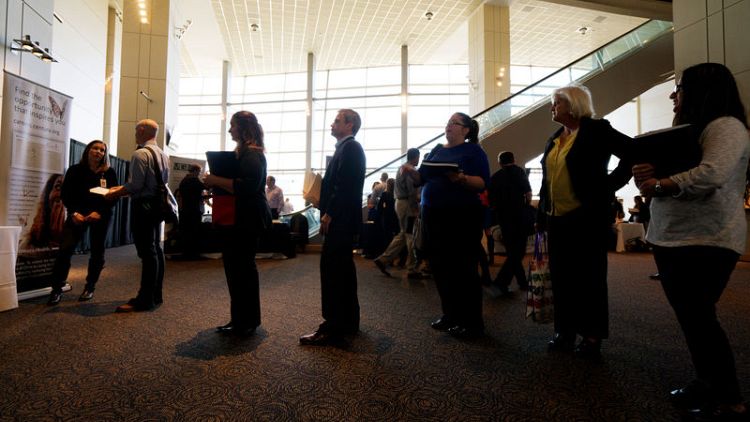By Jason Lange
WASHINGTON (Reuters) - The U.S. economy is adding lots of jobs, but a drop in the number of hours at work points to a dimmer outlook for economic growth as businesses brace for an escalating trade war with China.
Many economists think the economy only needs to add about 100,000 jobs a month to keep up with new entrants to the workforce. So data released on Friday showing 164,000 jobs were added in July suggests the historically low jobless rate might fall further.
That is, as long as the economy doesn't go into a recession.
The Labor Department's employment report for July showed an index of hours worked across the economy fell 0.2% in July. The index, which economists treat as an early indicator of economic growth, has been cooling for much of this year.
So far, this reading might only point to slower growth, rather than a sharp turn toward economic contraction. (For a graphic on growth slowdown, click https://tmsnrt.rs/336RHbk) "The slowing is taking place in a gradual and unthreatening fashion," said Michael Feroli, an economist at JPMorgan.
But there are worrisome signs in the economy. A significant part of the weakness in hours worked came from the manufacturing sector, which is particularly exposed to an escalating trade war with China.
President Donald Trump has raised tariffs on nearly half of China's imports to the United States, and on Thursday he said he planned to slap a 10% tariff on the remainder starting in September. The trade war has already led to Chinese retaliatory tariffs on U.S. exports, and Beijing on Friday vowed to respond with more punitive measures if Trump pushed ahead with the new tariffs. The trade tensions are weighing on the global economy as well.
That is hitting American factories, where the number of hours worked in July was actually smaller than the same month last year. (For a graphic on manufacturing jobs, click https://tmsnrt.rs/2KlWDkg)
The trade war is happening at the same time that the main driver of the U.S. economy - consumer spending - has stayed strong. This has helped the U.S. labour market continue to improve, even among workers who have been slower to see the fruits of the recovery from America's 2007-2009 recession.
In July, the number of workers who couldn't get full-time hours because of the economy fell below 4,000 for the first time since 2006. The number of unemployed Americans who have been looking for work at least 27 weeks fell to its lowest level since 2007. (For a graphic on full employment, click https://tmsnrt.rs/333lP7L)
(Reporting by Jason Lange; Editing by Paul Simao)



